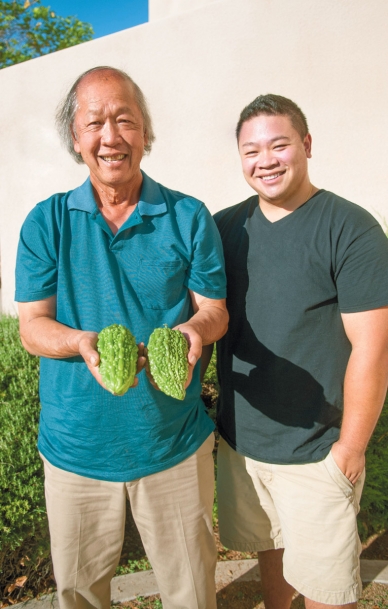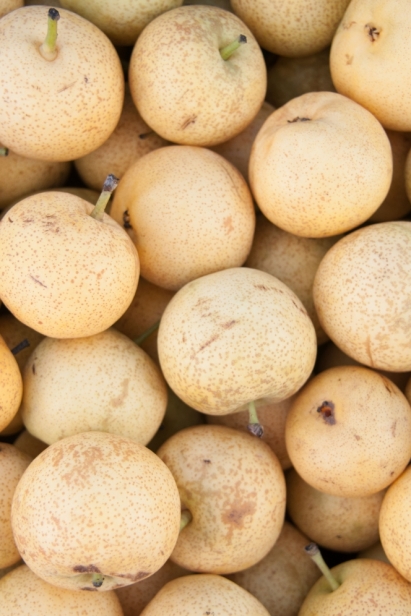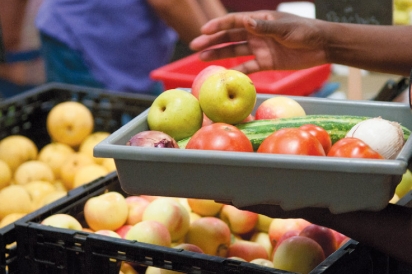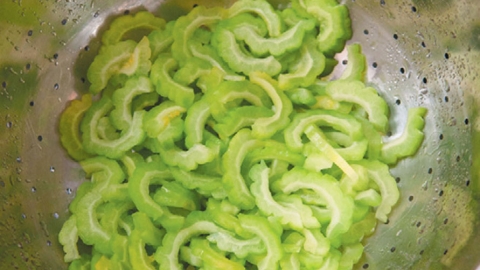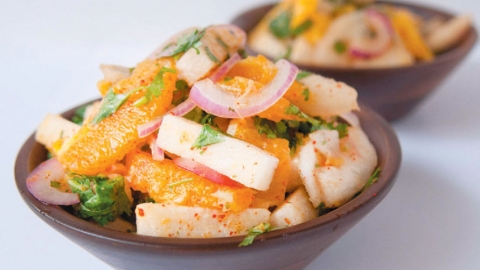Finding Culinary Inspiration with Wong Family Farm
Part of the fun of shopping at the farmers’ market is discovering unfamiliar or rare foods. The prospect of a culinary and gustatory adventure is exciting, whether it’s finding kumquat marmalade, a hearty German sourdough rye bread, a rare variety of date, heirloom apples or a hard-to-find vegetable.
The possibilities change every week as the season progresses. So, it is with eager anticipation that I approach Fred Wong’s booth at the Flagstaff Community Market.
His is a low-key, unmarked stand where the vegetables are displayed in bins, the prices marked on a board. But among the usual tomatoes, peppers, squash and onions you can spot striped Armenian cucumbers, “Tumbling Tom” hanging-basket tomatoes, small ears of sweet corn, Shiro yellow plums and rosy doughnut peaches. There may also be eye-catching Chinese long green eggplants, Shishito peppers, bright orange lunchbox peppers, elephant garlic, Chinese long beans and, in some years, gourds that the Hopi and Navajo use to create ceremonial rattles. Off to the side, unexpectedly, there is a big pot of steamed buns.
Fred and Tina Wong’s produce offerings reflect their Asian heritage and culinary tastes, and they offer some unique specialties not found at other booths. Consider the just-picked Asian pears: A fruit that has been grown for thousands of years in China, Japan, Korea and elsewhere in the Far East, these apple-like pears are fragrant, crisp and sweet. There are many varieties, with flavors ranging from floral to citrus, honey and walnut. Wong has five varieties. Mostly eaten raw, they complement many salads. I like to combine them with jicama, orange slices, lime juice, cilantro, pickled red onion, and jalapeño slivers. They are good with cabbage slaws too. While I have not baked the pears, I’ve seen recipes online that use them for cooked desserts.
I spy the Sonoran White pomegranate, a rare heirloom fruit planted by Spaniards in mission orchards, at their stall. I have not seen it for sale anywhere else, although heirloom orchardists in southern Arizona have recently planted it in restored mission gardens. Its tart, pink fruit has a milder taste than the red pomegranate, delicately refreshing, and the pale juice does not stain.
Persimmons, of which Wong has two varieties, grow bright and luscious on deep green, glossy-leaved shade trees by his house. So popular are they with wildlife, especially raccoons, that Wong installed electrified fences around the base of the trunks to protect the dusky-orange fruits. Wong has two types of persimmons that are ripe in the fall: the short, squat Fuyu variety that ripens a little earlier and the long Hachiya variety that arrives later and whose firm flesh becomes very tender when ripe. While Wong only eats the persimmons fresh, he says that some of his customers dehydrate them to store, or bake cookies with them.
Bitter melons are a very hot item at Wong’s stand. “At a recent market some Asian people came and bought a few melons,” says Wong. Then word got out, so others came to buy them, and soon after that people called me to ask for them. It was early in the market, but I had already sold out.”
There are many species of this member of the Cucurbitaceae family but the most commonly eaten type is a pale green, warty, cucumber-shaped fruit with a bitter taste. They have been used in Ayurvedic and Chinese medicine for thousands of years, and are said to possess antibacterial, anti-viral and anti-cancer properties. Eaten when young, Wong says they are delicious in stir-fries with other strong flavors, such as garlic, ginger, chili, beef and black bean paste. He saves the melon seeds to replant for the next season.
Until last year, the Wongs owned and operated the Grand Canyon Café in Flagstaff, which Wong’s father and uncle opened in 1943. The busy restaurant was not just a favorite for locals—it was a community institution.
“Until I went to college, I was always working in the kitchen of the Café,” says Wong. Along with Chinese specialties such as wonton soup, egg rolls, fried rice and chow mein, Wong also prepared American crowd pleasers such as green chili omelets, chicken fried steak and hamburgers.
Knowing firsthand how much work it takes to run a restaurant, I asked Wong why he became a farmer too. He says, “When I was a boy, a family friend had a fruit orchard in Cornville, and a small vegetable garden. When we visited the farm, I really noticed the flavors of the freshly picked fruits and vegetables. I enjoyed them so much I decided then that I wanted to have my own farm someday.”
So, after he took over the restaurant, Wong bought land in Cornville with irrigation rights. He grew fruits and vegetables to provide for his family, to share with neighbors and friends and to use in the restaurant.
Later, Fred and Tina acquired their first lot in Camp Verde where the irrigation was easier to manage. I went to visit them there.
“We bought this lot in 1992, and before building the house I planted the fruit trees,” he says as he gestures to the densely planted land around the house. Today the trees are laden with persimmons, Asian pears, apricots, plums, peaches and apples. Next to some grapevines, in a huge, repurposed watering trough, Tina Wong grows a special variety of sweet potatoes. “She uses just the leaves for stir-fries,” Wong tells me.
Eventually the Wongs sold the Cornville farm and bought two other parcels in their Camp Verde neighborhood. Astonishingly, along with managing and cooking in the restaurant, they farmed more than three acres of fertile bottomland by themselves, without herbicides, pesticides or chemical fertilizers.
Wong built a small greenhouse, constructed hoop frame structures and acquired several tractors, cultivators and other equipment. He built a 1,000-gallon concrete holding tank for flood irrigation but then decided to use drip irrigation as a water conservation effort. So he put in a couple of miles of drip lines on either side of the dozens of 200-foot rows. He grafted fruit scions, saved seeds and hauled manure from local farms.
On Sundays, when the restaurant was closed, the Wongs started selling their produce at the Flagstaff Community Market.
“I really don’t know how we did it all in those days” says Wong. Considering the herculean effort involved in both enterprises, I ask if he had considered looking for help. He says, “Sometimes my son comes to help out, but people really don’t want to work on a farm these days.”
Now free of the restaurant’s demands, he sells at the Wednesday and Sunday markets in Flagstaff, and at the Saturday Uptown Farmers Market in Phoenix.
Wong is both farmer and chef—an inspiring example of the farm-to-table concept before the term was coined. When I return home and observe the rich colors, flavors and culinary opportunities in my basket of vegetables, I consider the work he has described, and I am truly grateful for the bounty that Fred and Tina Wong, and small farmers like them, have brought to our tables. As I cook and savor these foods, I find inspiration from the passion for authentic flavor that motivated Wong and I think about the next discovery that I’ll make at his farmers’ market stand.


